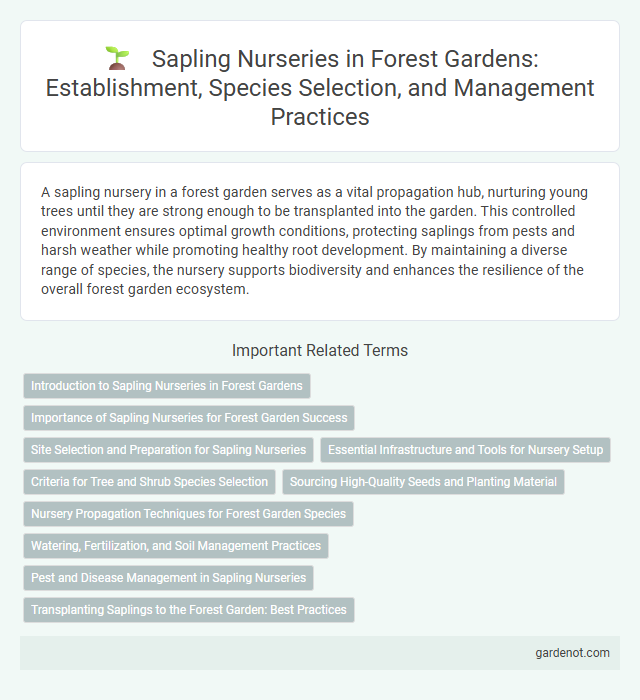A sapling nursery in a forest garden serves as a vital propagation hub, nurturing young trees until they are strong enough to be transplanted into the garden. This controlled environment ensures optimal growth conditions, protecting saplings from pests and harsh weather while promoting healthy root development. By maintaining a diverse range of species, the nursery supports biodiversity and enhances the resilience of the overall forest garden ecosystem.
Introduction to Sapling Nurseries in Forest Gardens
Sapling nurseries in forest gardens serve as critical hubs for propagating diverse tree species that contribute to ecosystem stability and productivity. These nurseries optimize growth conditions, ensuring young plants develop strong root systems and adaptive traits suited for agroforestry integration. Proper management of sapling nurseries accelerates reforestation efforts and enhances biodiversity within sustainable forest garden designs.
Importance of Sapling Nurseries for Forest Garden Success
Sapling nurseries play a crucial role in forest garden success by providing healthy, well-established young trees that ensure higher survival rates and faster growth. These nurseries enable the selection of species best suited to local soil and climate conditions, enhancing biodiversity and long-term sustainability. By nurturing saplings in controlled environments, nurseries reduce disease risk and improve the overall resilience of the forest garden ecosystem.
Site Selection and Preparation for Sapling Nurseries
Choosing an ideal site for a sapling nursery involves prioritizing well-drained soil with adequate sunlight exposure and proximity to water sources for efficient irrigation. Preparing the land includes clearing debris, loosening the soil to enhance aeration, and enriching it with organic matter or compost to promote healthy root development. Proper site selection and meticulous preparation directly influence the growth rate and survival of saplings in forest garden systems.
Essential Infrastructure and Tools for Nursery Setup
A successful sapling nursery requires essential infrastructure such as raised seedbeds, shade nets, and efficient irrigation systems to ensure optimal growth conditions. Tools like pruning shears, seed trays, and soil moisture meters enhance nursery management and seedling health. Proper layout planning maximizes space utilization and facilitates easy maintenance, promoting healthy sapling development.
Criteria for Tree and Shrub Species Selection
Selecting tree and shrub species for a sapling nursery in a forest garden relies on criteria such as local climate adaptability, soil compatibility, and growth rate. Prioritizing native or well-adapted species enhances biodiversity and ensures resilience against pests and diseases. Emphasizing species that provide functional benefits like nitrogen fixation, fruit production, or habitat creation supports a sustainable and productive forest garden ecosystem.
Sourcing High-Quality Seeds and Planting Material
Sourcing high-quality seeds and planting material for a sapling nursery is essential to ensure robust growth and healthy forest garden development. Selecting certified, genetically diverse seeds from reputable suppliers increases the resilience and productivity of the saplings. Employing proper storage, handling, and germination techniques further maximizes the success rate of seedling establishment in the nursery.
Nursery Propagation Techniques for Forest Garden Species
Sapling nurseries for forest garden species utilize propagation techniques such as seed stratification, cuttings, and grafting to ensure healthy and vigorous plant development. Controlled environments in nurseries optimize germination rates and root establishment by regulating humidity, temperature, and light exposure specific to species like persimmon, pawpaw, and hazelnut. These propagation methods increase survival rates and promote biodiversity essential for sustainable forest garden ecosystems.
Watering, Fertilization, and Soil Management Practices
Effective sapling nursery management in forest gardens relies on consistent watering schedules that maintain soil moisture without causing waterlogging, promoting healthy root development. Fertilization strategies often incorporate organic compost and balanced nutrient mixes to support robust growth and enhance soil fertility. Soil management practices include regular mulching and aeration to improve soil structure, nutrient retention, and microbial activity essential for sapling vitality.
Pest and Disease Management in Sapling Nurseries
Effective pest and disease management in sapling nurseries is crucial for healthy forest garden establishment. Implementing integrated pest management (IPM) strategies, including regular monitoring, biological controls like beneficial insects, and selective use of organic pesticides, minimizes damage to young plants. Maintaining proper sanitation and optimal growing conditions further reduces the risk of fungal infections and pest infestations in sapling nurseries.
Transplanting Saplings to the Forest Garden: Best Practices
Transplanting saplings to a forest garden requires careful site selection with adequate sunlight, soil moisture, and protection from wind to ensure healthy growth. Saplings should be acclimated gradually through hardening off, and planting holes must be prepared with nutrient-rich compost to support root establishment. Proper mulching around the base conserves moisture, suppresses weeds, and fosters a microclimate conducive to sapling survival in the forest garden ecosystem.
Sapling nursery Infographic

 gardenot.com
gardenot.com